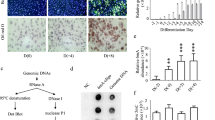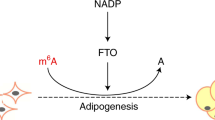Abstract
Background/Objectives:
Adipose tissue is one of the main organs regulating energy homeostasis via energy storage as well as endocrine function. The adipocyte cell number is largely determined by adipogenesis. While the molecular mechanism of adipogenesis has been extensively studied, its role in dynamic DNA methylation plasticity remains unclear. Recently, it has been shown that Tet methylcytosine dioxygenase (TET) is catalytically capable of oxidizing DNA 5-methylcytosine (5-mC) to 5-hydroxymethylcytosine (5-hmC) toward a complete removal of the methylated cytosine. We investigate whether expression of the Tet genes and production of hydroxymethylcytosine are required for preadipocyte differentiation.
Subjects/Methods:
Murine 3T3-L1 preadipocytes were used to evaluate the role of Tet1 and Tet2 genes during adipogenesis. Changes in adipogenic ability and in epigenetic status were analyzed, with and without interfering Tet1 and Tet2 expression using small interfering RNA (siRNA). The adipogenesis was evaluated by Oil-Red-O staining and induced expression of adipogenic genes using quantitative polymerase chain reaction (qPCR). Levels of 5-hmC and 5-mC were measured by MassARRAY, immunoprecipitation and GC mass spectrometry at specific loci as well as globally.
Results:
Both Tet1 and Tet2 genes were upregulated in a time-dependent manner, accompanied by increased expression of hallmark adipogenic genes such as Pparγ and Fabp4 (P<0.05). The TET upregulation led to reduced DNA methylation and elevated hydroxymethylcytosine, both globally and specifically at the Pparγ locus (P<0.05 and P<0.01, respectively). Knockdown of Tet1 and Tet2 blocked adipogenesis (P<0.01) by repression of Pparγ expression (P<0.05). In particular, Tet2 knockdown repressed conversion of 5-mC to 5-hmC at the Pparγ locus (P<0.01). Moreover, vitamin C treatment enhanced adipogenesis (P<0.05), while fumarate treatment inhibited it (P<0.01) by modulating TET activities.
Conclusions:
TET proteins, particularly TET2, were required for adipogenesis by modulating DNA methylation at the Pparγ locus, subsequently by inducing Pparγ gene expression.
This is a preview of subscription content, access via your institution
Access options
Subscribe to this journal
Receive 12 print issues and online access
$259.00 per year
only $21.58 per issue
Buy this article
- Purchase on Springer Link
- Instant access to full article PDF
Prices may be subject to local taxes which are calculated during checkout




Similar content being viewed by others
References
Galic S, Oakhill JS, Steinberg GR . Adipose tissue as an endocrine organ. Mol Cell Endocrinol 2010; 316: 129–139.
Christy RJ, Yang VW, Ntambi JM, Geiman DE, Landschulz WH, Friedman AD et al. Differentiation-induced gene expression in 3T3-L1 preadipocytes: CCAAT/enhancer binding protein interacts with and activates the promoters of two adipocyte-specific genes. Genes Dev 1989; 3: 1323–1335.
Rosen ED, Sarraf P, Troy AE, Bradwin G, Moore K, Milstone DS et al. PPAR gamma is required for the differentiation of adipose tissue in vivo and in vitro. Mol Cell 1999; 4: 611–617.
Rosen ED, Spiegelman BM . PPARgamma: a nuclear regulator of metabolism, differentiation, and cell growth. J Biol Chem 2001; 276: 37731–37734.
Rosen ED, Hsu CH, Wang X, Sakai S, Freeman MW, Gonzalez FJ et al. C/EBPalpha induces adipogenesis through PPARgamma: a unified pathway. Genes Dev 2002; 16: 22–26.
Tang QQ, Zhang JW, Daniel Lane M . Sequential gene promoter interactions of C/EBPbeta, C/EBPalpha, and PPARgamma during adipogenesis. Biochem Biophys Res Commun 2004; 319: 235–239.
Kubota N, Terauchi Y, Miki H, Tamemoto H, Yamauchi T, Komeda K et al. PPAR gamma mediates high-fat diet-induced adipocyte hypertrophy and insulin resistance. Mol Cell 1999; 4: 597–609.
Tontonoz P, Hu E, Spiegelman BM . Stimulation of adipogenesis in fibroblasts by PPAR gamma 2, a lipid-activated transcription factor. Cell 1994; 79: 1147–1156.
Wu Z, Rosen ED, Brun R, Hauser S, Adelmant G, Troy AE et al. Cross-regulation of C/EBP alpha and PPAR gamma controls the transcriptional pathway of adipogenesis and insulin sensitivity. Mol Cell 1999; 3: 151–158.
Knouff C, Auwerx J . Peroxisome proliferator-activated receptor-gamma calls for activation in moderation: lessons from genetics and pharmacology. Endocr Rev 2004; 25: 899–918.
Jaenisch R, Bird A . Epigenetic regulation of gene expression: how the genome integrates intrinsic and environmental signals. Nat Genet 2003; 33: 245–254.
Holliday R, Pugh JE . DNA modification mechanisms and gene activity during development. Science 1975; 187: 226–232.
Fouse SD, Shen Y, Pellegrini M, Cole S, Meissner A, Van Neste L et al. Promoter CpG methylation contributes to ES cell gene regulation in parallel with Oct4/Nanog, PcG complex, and histone H3 K4/K27 trimethylation. Cell Stem Cell 2008; 2: 160–169.
Robertson KD . DNA methylation, methyltransferases, and cancer. Oncogene 2001; 20: 3139–3155.
Moore LD, Le T, Fan G . DNA methylation and its basic function. Neuropsychopharmacology 2013; 38: 23–38.
Crider KS, Yang TP, Berry RJ, Bailey LB . Folate and DNA methylation: a review of molecular mechanisms and the evidence for folate's role. Adv Nutr 2012; 3: 21–38.
Tahiliani M, Koh KP, Shen Y, Pastor WA, Bandukwala H, Brudno Y et al. Conversion of 5-methylcytosine to 5-hydroxymethylcytosine in mammalian DNA by MLL partner TET1. Science 2009; 324: 930–935.
Ito S, Shen L, Dai Q, Wu SC, Collins LB, Swenberg JA et al. Tet proteins can convert 5-methylcytosine to 5-formylcytosine and 5-carboxylcytosine. Science 2011; 333: 1300–1303.
Wu H, D'Alessio AC, Ito S, Wang Z, Cui K, Zhao K et al. Genome-wide analysis of 5-hydroxymethylcytosine distribution reveals its dual function in transcriptional regulation in mouse embryonic stem cells. Genes Dev 2011; 25: 679–684.
Ficz G, Branco MR, Seisenberger S, Santos F, Krueger F, Hore TA et al. Dynamic regulation of 5-hydroxymethylcytosine in mouse ES cells and during differentiation. Nature 2011; 473: 398–402.
Steger DJ, Grant GR, Schupp M, Tomaru T, Lefterova MI, Schug J et al. Propagation of adipogenic signals through an epigenomic transition state. Genes Dev 2010; 24: 1035–1044.
Wakabayashi K, Okamura M, Tsutsumi S, Nishikawa NS, Tanaka T, Sakakibara I et al. The peroxisome proliferator-activated receptor gamma/retinoid X receptor alpha heterodimer targets the histone modification enzyme PR-Set7/Setd8 gene and regulates adipogenesis through a positive feedback loop. Mol Cell Biol 2009; 29: 3544–3555.
Lee J, Saha PK, Yang QH, Lee S, Park JY, Suh Y et al. Targeted inactivation of MLL3 histone H3-Lys-4 methyltransferase activity in the mouse reveals vital roles for MLL3 in adipogenesis. Proc Natl Acad Sci USA 2008; 105: 19229–19234.
Wang L, Xu S, Lee JE, Baldridge A, Grullon S, Peng W et al. Histone H3K9 methyltransferase G9a represses PPARgamma expression and adipogenesis. EMBO J 2013; 32: 45–59.
Lu C, Ward PS, Kapoor GS, Rohle D, Turcan S, Abdel-Wahab O et al. IDH mutation impairs histone demethylation and results in a block to cell differentiation. Nature 2012; 483: 474–478.
Yokomori N, Tawata M, Onaya T . DNA demethylation modulates mouse leptin promoter activity during the differentiation of 3T3-L1 cells. Diabetologia 2002; 45: 140–148.
Noer A, Sorensen AL, Boquest AC, Collas P . Stable CpG hypomethylation of adipogenic promoters in freshly isolated, cultured, and differentiated mesenchymal stem cells from adipose tissue. Mol Biol Cell 2006; 17: 3543–3556.
Serandour AA, Avner S, Oger F, Bizot M, Percevault F, Lucchetti-Miganeh C et al. Dynamic hydroxymethylation of deoxyribonucleic acid marks differentiation-associated enhancers. Nucleic Acids Res 2012; 40: 8255–8265.
Green H, Meuth M . An established pre-adipose cell line and its differentiation in culture. Cell 1974; 3: 127–133.
Arsenijevic T, Gregoire F, Delforge V, Delporte C, Perret J . Murine 3T3-L1 adipocyte cell differentiation model: validated reference genes for qPCR gene expression analysis. PloS one 2012; 7: e37517.
Tang X, Zhen Q, Fan Z, Feng C, Ding M . [Determination of homocysteine in plasma by precolumn derivatization-high performance liquid chromatography with fluorescence detection]. Se Pu 2012; 30: 613–617.
Green H, Kehinde O . An established preadipose cell line and its differentiation in culture. II. Factors affecting the adipose conversion. Cell 1975; 5: 19–27.
Blaschke K, Ebata KT, Karimi MM, Zepeda-Martinez JA, Goyal P, Mahapatra S et al. Vitamin C induces Tet-dependent DNA demethylation and a blastocyst-like state in ES cells. Nature 2013; 500: 222–226.
Xiao M, Yang H, Xu W, Ma S, Lin H, Zhu H et al. Inhibition of alpha-KG-dependent histone and DNA demethylases by fumarate and succinate that are accumulated in mutations of FH and SDH tumor suppressors. Genes Dev 2012; 26: 1326–1338.
Bernstein BE, Meissner A, Lander ES . The mammalian epigenome. Cell 2007; 128: 669–681.
Sakamoto H, Kogo Y, Ohgane J, Hattori N, Yagi S, Tanaka S et al. Sequential changes in genome-wide DNA methylation status during adipocyte differentiation. Biochem Biophys Res Commun 2008; 366: 360–366.
Wu H, Zhang Y . Mechanisms and functions of Tet protein-mediated 5-methylcytosine oxidation. Genes Dev 2011; 25: 2436–2452.
Fujiki K, Shinoda A, Kano F, Sato R, Shirahige K, Murata M . PPARgamma-induced PARylation promotes local DNA demethylation by production of 5-hydroxymethylcytosine. Nat Commun 2013; 4: 2262.
Dubois-Chevalier J, Oger F, Dehondt H, Firmin FF, Gheeraert C, Staels B et al. A dynamic CTCF chromatin binding landscape promotes DNA hydroxymethylation and transcriptional induction of adipocyte differentiation. Nucleic Acids Res 2014; 42: 10943–10959.
Ko M, An J, Bandukwala HS, Chavez L, Aijo T, Pastor WA et al. Modulation of TET2 expression and 5-methylcytosine oxidation by the CXXC domain protein IDAX. Nature 2013; 497: 122–126.
Koh KP, Yabuuchi A, Rao S, Huang Y, Cunniff K, Nardone J et al. Tet1 and Tet2 regulate 5-hydroxymethylcytosine production and cell lineage specification in mouse embryonic stem cells. Cell Stem Cell 2011; 8: 200–213.
Huang Y, Chavez L, Chang X, Wang X, Pastor WA, Kang J et al. Distinct roles of the methylcytosine oxidases Tet1 and Tet2 in mouse embryonic stem cells. Proc Natl Acad Sci USA 2014; 111: 1361–1366.
Loenarz C, Schofield CJ . Expanding chemical biology of 2-oxoglutarate oxygenases. Nature chemical biology 2008; 4: 152–156.
Salminen A, Kauppinen A, Hiltunen M, Kaarniranta K . Krebs cycle intermediates regulate DNA and histone methylation: epigenetic impact on the aging process. Ageing research reviews 2014; 16: 45–65.
Acknowledgements
This work was supported by the National Research Foundation of Korea (NRF) grant funded by the Korea government (MEST) (2014R1A1A2058942 to YJP and 2014R1A1A2058964 to AML). YY and JHP were supported by the Brain Korea 21 Plus Project in 2013 (22A20130012143).
Author information
Authors and Affiliations
Corresponding author
Ethics declarations
Competing interests
The authors declare no conflict of interest.
Rights and permissions
About this article
Cite this article
Yoo, Y., Park, J., Weigel, C. et al. TET-mediated hydroxymethylcytosine at the Pparγ locus is required for initiation of adipogenic differentiation. Int J Obes 41, 652–659 (2017). https://doi.org/10.1038/ijo.2017.8
Received:
Revised:
Accepted:
Published:
Issue Date:
DOI: https://doi.org/10.1038/ijo.2017.8
This article is cited by
-
A negative feedback loop between TET2 and leptin in adipocyte regulates body weight
Nature Communications (2024)
-
Targeted erasure of DNA methylation by TET3 drives adipogenic reprogramming and differentiation
Nature Metabolism (2022)
-
miR-410-3P inhibits adipocyte differentiation by targeting IRS-1 in cancer-associated cachexia patients
Lipids in Health and Disease (2021)
-
The trans-ancestral genomic architecture of glycemic traits
Nature Genetics (2021)
-
TET1 is a beige adipocyte-selective epigenetic suppressor of thermogenesis
Nature Communications (2020)



